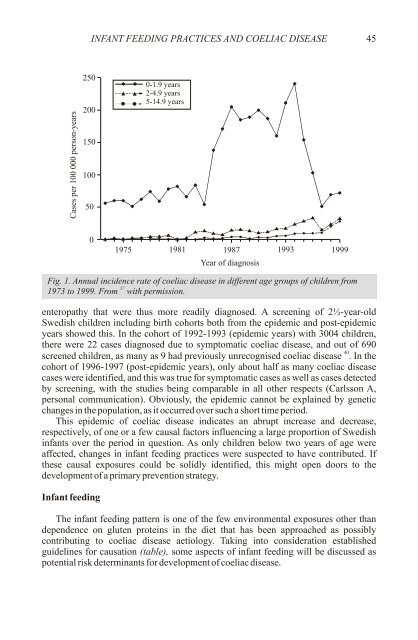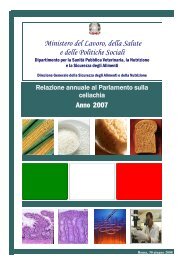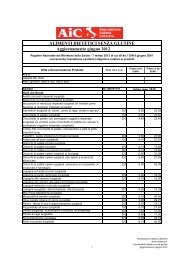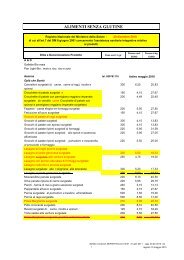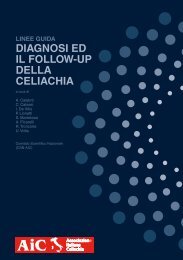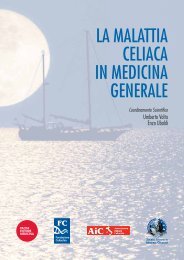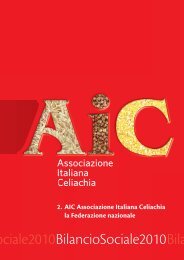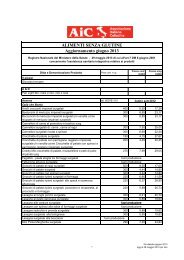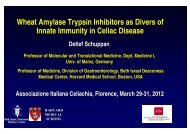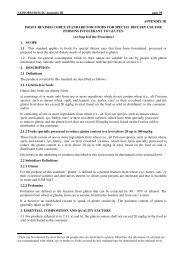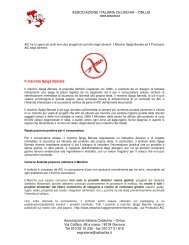primary prevention of coeliac disease - Associazione Italiana ...
primary prevention of coeliac disease - Associazione Italiana ...
primary prevention of coeliac disease - Associazione Italiana ...
You also want an ePaper? Increase the reach of your titles
YUMPU automatically turns print PDFs into web optimized ePapers that Google loves.
INFANT FEEDING PRACTICES AND COELIAC DISEASE<br />
45<br />
Cases per 100 000 person-years<br />
250<br />
200<br />
150<br />
100<br />
50<br />
0-1.9 years<br />
2-4.9 years<br />
5-14.9 years<br />
0<br />
1975 1981 1987 1993 1999<br />
Year <strong>of</strong> diagnosis<br />
Fig. 1. Annual incidence rate <strong>of</strong> <strong>coeliac</strong> <strong>disease</strong> in different age groups <strong>of</strong> children from<br />
37<br />
1973 to 1999. From with permission.<br />
enteropathy that were thus more readily diagnosed. A screening <strong>of</strong> 2½-year-old<br />
Swedish children including birth cohorts both from the epidemic and post-epidemic<br />
years showed this. In the cohort <strong>of</strong> 1992-1993 (epidemic years) with 3004 children,<br />
there were 22 cases diagnosed due to symptomatic <strong>coeliac</strong> <strong>disease</strong>, and out <strong>of</strong> 690<br />
40<br />
screened children, as many as 9 had previously unrecognised <strong>coeliac</strong> <strong>disease</strong> . In the<br />
cohort <strong>of</strong> 1996-1997 (post-epidemic years), only about half as many <strong>coeliac</strong> <strong>disease</strong><br />
cases were identified, and this was true for symptomatic cases as well as cases detected<br />
by screening, with the studies being comparable in all other respects (Carlsson A,<br />
personal communication). Obviously, the epidemic cannot be explained by genetic<br />
changes in the population, as it occurred over such a short time period.<br />
This epidemic <strong>of</strong> <strong>coeliac</strong> <strong>disease</strong> indicates an abrupt increase and decrease,<br />
respectively, <strong>of</strong> one or a few causal factors influencing a large proportion <strong>of</strong> Swedish<br />
infants over the period in question. As only children below two years <strong>of</strong> age were<br />
affected, changes in infant feeding practices were suspected to have contributed. If<br />
these causal exposures could be solidly identified, this might open doors to the<br />
development <strong>of</strong> a <strong>primary</strong> <strong>prevention</strong> strategy.<br />
Infant feeding<br />
The infant feeding pattern is one <strong>of</strong> the few environmental exposures other than<br />
dependence on gluten proteins in the diet that has been approached as possibly<br />
contributing to <strong>coeliac</strong> <strong>disease</strong> aetiology. Taking into consideration established<br />
guidelines for causation (table), some aspects <strong>of</strong> infant feeding will be discussed as<br />
potential risk determinants for development <strong>of</strong> <strong>coeliac</strong> <strong>disease</strong>.


